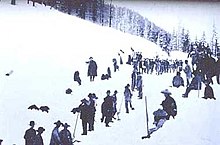Chinese Exclusion Act

The Chinese Exclusion Act ( German law for the exclusion of the Chinese ) was a federal law of the United States that was passed by the US Congress on May 6, 1882. The content of the Chinese Exclusion Act continued the 1880 revision of the Burlingame Treaty concluded in 1868 . With the revision of the Burlingame Treaty, the immigration of Chinese migrants to the United States was suspended, a measure that was enshrined in the Chinese Exclusion Act.
History and regulations
The Chinese Exclusion Act stipulated that no Chinese workers (English: laborers ) were allowed to immigrate to the United States for a period of 10 years . Applicants who were business people or highly qualified specialists were often simply classified as workers in order to deny them entry.
In 1884 supplementary laws followed ( Chinese Exclusion Act, 1884 Amendments ), which made immigration more difficult. Immigrants were prevented from returning to the United States after leaving the country. The restrictions have been extended to include ethnic Chinese, regardless of an applicant's nationality. The provisions of the Chinese Exclusion Act could subsequently also be applied to Chinese who were citizens of countries other than China. Even American citizens of Chinese origin were not exempt. The Geary Act , passed in 1892 , extended the validity of the provisions of the Chinese Exclusion Act by 10 years. In 1902 there was a further extension, this time for an indefinite period.
In 1943 with the Magnuson Act , the Chinese Exclusion Act tended to be repealed. The immigration of Chinese applicants was in principle allowed again, but as a result of the general immigration laws of 1921 and 1924, it was subject to a quota system, according to which no more than 105 Chinese new immigrants were allowed to enter each year. It was not until the Immigration and Nationality Services Act of 1965 that these quotas were lifted, so that Chinese immigrants were not allowed to enter the USA again until 1965.
background
Relatively few Chinese immigrated to the United States in the first half of the 19th century. According to official statistics, only 42 Chinese came to America around 1853 - although their actual number may have been higher. After that, the numbers rose; In 1854, 13,100 Chinese immigrants were registered. In 1880 there were about 100,000 Chinese in America, most of them on the west coast of California and Hawaii .
The Chinese Exclusion Act was initiated by an anti-Chinese political current in the western United States. Against the background of an economic crisis in the 1870s, the Chinese immigrants were associated with the risk of wage dumping and viewed as competitors for the fewer jobs. However, since the share of the Chinese among the immigrants was comparatively small overall (3.1% in 1854, 5.0% in 1882 with around 39,000), the passing of the Chinese Exclusion Act, which was directed exclusively against the Chinese, is probably mainly due to one Xenophobia and racism associated with anti-Chinese nativism .
The Chinese Exclusion Act was the first immigration law in US history to restrict the immigration of a group of people based on their ethnicity. In a lock negotiated by the Imperial Japanese and the US government ( Gentlemen's Agreement 1907 ), almost 25 years later, the influx of Japanese into the United States was restricted. In Australia , Canada and New Zealand , too , there were intermittent laws with a similar ethnically restrictive tendency.
Despite the Chinese Exclusion Act and its subsequent laws, the influx of Chinese immigrants to the US did not stop completely, but it fell dramatically. From 1910 to 1940 the Immigration and Naturalization Service operated an immigration office on Angel Island near San Francisco, where Chinese applicants were often made to wait months for permission to enter. Due to the deterioration in the legal status and the widespread sinophobia, tens of thousands of Chinese immigrants left the country again in the following decades.
See also
- Anarchist Exclusion Act
- Chronology of the Racial Laws of the United States
- Immigration Act of 1924
- History of the Chinese in the United States
- History of the Chinese in Hawaii
literature
- Edlie L. Wong: Racial Reconstruction: Black Inclusion, Chinese Exclusion, and the Fictions of Citizenship. NYU Press, New York 2015, ISBN 978-1-4798-1796-2 .
Web links
- Legal text (English).
- Chinese Exclusion Act of 1882 and Chinese Exclusion Act, 1884 Amendments (Explanatory Notes, English).
- Dennis Kearney , Workingmen's Party of California : Appeal from California. The Chinese Invasion. Workingmen's Address. In: The Indianapolis Times , February 28, 1878 (English).
- Exclusion Act Case Files of Yee Wee Thing and Yee Bing Quai, two "Paper Sons" (English).
- Eloise Paananen, George Tsui: Chinese in America. In: World and I (English).
- Henry Kittredge Norton: The Story of California From the Earliest Days to the Present. 7th edition. AC McClurg & Co., Chicago 1924, Chapter 24: Gold Rush and Anti-Chinese Race Hatred 1849 , pp. 283-296.
- Cases before the Supreme Court : Chae Chan Ping v. United States, 130 US 581 1889 and Wong Wing v. United States, 163 US 228 1896 (English).
Individual evidence
- ^ Robert A. Burchell: Immigration to America in the 19th and 20th centuries . In: Willi Paul Adams (ed.): The United States of America (= Fischer Weltgeschichte . Volume 30). Fischer Taschenbuch, Frankfurt am Main 1977, pp. 184-234, here p. 192 f.
- ^ Robert A. Burchell: Immigration to America in the 19th and 20th centuries . In: Willi Paul Adams (ed.): The United States of America (= Fischer Weltgeschichte . Volume 30). Fischer Taschenbuch, Frankfurt am Main 1977, pp. 184-234, here p. 193 f.
- ^ Robert A. Burchell: Immigration to America in the 19th and 20th centuries . In: Willi Paul Adams (ed.): The United States of America (= Fischer Weltgeschichte . Volume 30). Fischer Taschenbuch, Frankfurt am Main 1977, pp. 184–234, here p. 195.
